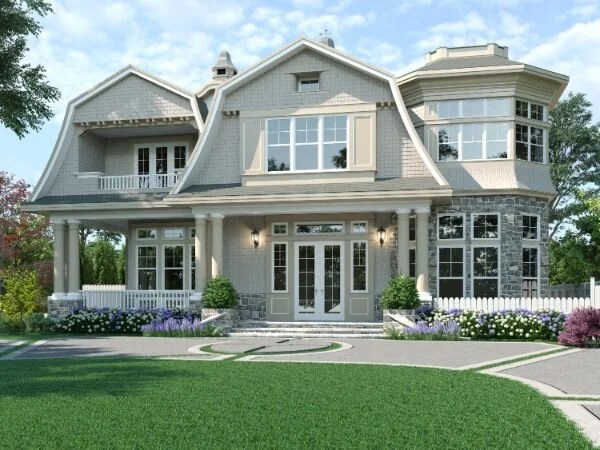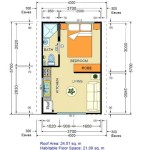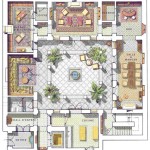3D Rendering of House Plans: Understanding the Costs
The visualization of architectural designs through 3D rendering has become an integral part of the construction and real estate industries. This technology allows stakeholders to gain a realistic preview of a planned structure before construction commences, facilitating informed decision-making and minimizing potential errors. However, the cost associated with 3D rendering of house plans can vary widely, depending on a multitude of factors. Understanding these factors is crucial for budgeting and ensuring a return on investment.
3D rendering transforms 2D architectural drawings into photorealistic or stylized images and animations. These visualizations can showcase interior and exterior designs, landscaping, and even lighting conditions. This level of detail allows potential buyers, investors, and even the construction team to fully grasp the design intent and identify potential issues early in the process. This article aims to explore the various aspects that influence the cost of 3D rendering services, providing a comprehensive overview for individuals and businesses seeking to utilize this technology.
Complexity of the Design
The complexity of the architectural design is a primary driver of the cost of 3D rendering. Simple, box-like structures with minimal detailing will naturally be less expensive to render than intricate designs featuring complex geometries, curved surfaces, and elaborate ornamentation. The level of detail required in the rendering process directly impacts the time and resources needed to create the final product.
Factors contributing to design complexity include the number of different materials used in the design. Each material requires careful texturing and shading to accurately simulate its appearance. Furthermore, the presence of custom architectural elements, such as specialized windows, intricate railings, or unique roof structures, increases the modeling and rendering time. Intricate landscaping with diverse plants and topography will also add to the overall complexity and cost.
Interior renderings, in particular, are often more expensive than exterior renderings due to the level of detail required. Including furniture, appliances, and decorative elements necessitates careful modeling and texturing to create a realistic and appealing environment. The accurate representation of lighting and shadows within an interior space also requires significant expertise and rendering time.
The accuracy of the provided architectural plans also impacts cost. If the plans are incomplete, inaccurate, or lack sufficient detail, the rendering artist will need to spend additional time clarifying details, making assumptions, or even recreating portions of the design. This will inevitably increase the overall cost of the rendering project. Therefore, providing clear, comprehensive, and accurate architectural plans is essential for minimizing rendering expenses.
Level of Detail and Realism
The desired level of detail and realism is another significant factor influencing the cost of 3D rendering. Photorealistic renderings, which aim to replicate reality as closely as possible, require significantly more time and resources than stylized or more abstract renderings. Achieving photorealism involves meticulous attention to detail in modeling, texturing, lighting, and post-processing.
High-resolution textures are essential for creating realistic surfaces. These textures provide detailed information about the surface's color, reflectivity, and bumpiness. Sourcing or creating high-quality textures can be time-consuming and costly. The use of advanced lighting techniques, such as global illumination and ray tracing, is also necessary for achieving photorealistic lighting effects. These techniques simulate the way light interacts with surfaces in the real world, creating more accurate and believable shadows and reflections.
The level of detail in the surrounding environment also contributes to the overall realism. Including detailed landscaping, surrounding buildings, and even people adds to the complexity of the scene and increases the rendering time. Post-processing techniques, such as color correction, sharpening, and adding atmospheric effects, are often used to further enhance the realism of the final rendering.
Different industries have different expectations regarding the level of detail and realism. For example, real estate marketing materials often require highly photorealistic renderings to entice potential buyers. On the other hand, preliminary design visualizations may require a lower level of detail, focusing more on the overall form and massing of the building.
Experience and Location of the Rendering Artist or Firm
The experience and location of the rendering artist or firm play a crucial role in determining the cost of 3D rendering services. Experienced artists and firms typically charge higher rates due to their expertise, efficiency, and ability to deliver high-quality results. They possess the knowledge and skills to handle complex projects, troubleshoot problems, and create visually appealing and accurate renderings.
The location of the rendering artist or firm can also impact the cost. Rendering services located in major metropolitan areas often have higher overhead costs, which are reflected in their pricing. Outsourcing rendering projects to countries with lower labor costs can be a cost-effective option, but it's important to carefully consider the quality of work and communication challenges.
When selecting a rendering artist or firm, it's important to review their portfolio and testimonials to assess their skills and experience. Look for examples of work that are similar to the project in terms of style, complexity, and level of detail. Requesting a sample rendering or a small test project can help evaluate the artist's capabilities and ensure they can meet the required standards.
Communication is also a critical factor to consider. Effective communication ensures that the artist fully understands the design intent and can deliver renderings that meet the client's expectations. It's important to establish clear communication channels and provide detailed feedback throughout the rendering process.
Beyond the direct creation of the images, the pricing might include additional services. Some rendering firms offer services such as virtual staging, where furniture and decorations are digitally added to interior renderings to make the space more appealing. They might also offer walkthrough animations, providing potential buyers with a virtual tour of the property. These additional services will invariably increase the overall cost.
The software used by the rendering artist or firm can also influence the cost. Professional-grade rendering software often requires expensive licenses and specialized hardware. Artists who invest in these tools are typically able to produce higher-quality renderings more efficiently, but their prices may reflect the cost of their investments.
Finally, the turnaround time required for the rendering project can affect the cost. Rush orders, which require the artist to work overtime or prioritize the project, will typically be more expensive than projects with a longer lead time. It's essential to plan ahead and provide the artist with sufficient time to complete the project to avoid rush fees.
In summary, the cost of 3D rendering of house plans is influenced by a complex interplay of factors. Understanding these factors and carefully considering the project requirements is essential for budgeting and selecting the right rendering artist or firm. By providing clear and comprehensive architectural plans, defining the desired level of detail and realism, and carefully evaluating the experience and location of potential rendering providers, individuals and businesses can maximize the value of their investment in 3D rendering services.
Accurate cost estimation requires a detailed understanding of project scope. This includes the number of views or angles required. A single exterior rendering will obviously cost less than a package including multiple interior and exterior views. The level of post-production processing also impacts the final price. Extensive retouching or the addition of special effects will naturally add to the overall expense.
The geographical location of the property itself can also be a factor. Rendering a house in a mountainous landscape, for example, may require additional effort to accurately depict the surrounding terrain and vegetation. Similarly, houses located in dense urban environments may necessitate the inclusion of surrounding buildings, which adds to the complexity of the scene.
Ultimately, the key to managing the cost of 3D rendering is to communicate effectively with the rendering artist or firm and to provide them with all the necessary information to accurately assess the project requirements. This includes detailed architectural plans, clear specifications for the desired level of detail and realism, and a realistic timeline for completion.

How Much Do 3d House Plans Cost Faqs Answered Cedreo

How Much Do 3d House Plans Cost Faqs Answered Cedreo

How Much Does 3d Architectural Rendering Cost Guide

3d Rendering Costs Visualization S For Firms Cad Crowd

3d Floor Plan Cost

Architectural 3d Rendering Cost And Fee 310 431 7860 Agcaddesign Gmail Com

How Much Does 3d Architectural Rendering Cost Guide

How Much Do 3d Architectural Services Cost Vinnomedia

3d Rendering Costs Visualization S For Firms Cad Crowd

3d Floor Plans Renderings Visualizations Fast Delivery








